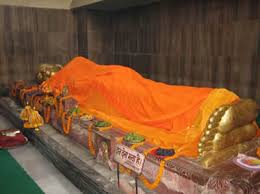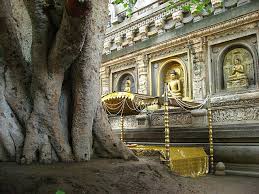|
|
|---|
| Infront of Royal Thai Temple, Bodhgaya -824231 Gaya (Bihar) INDIA |
Kushinagar
Kushinagar (Kushinara) is situated in eastern Uttar Pradesh, India is the final resting place of the Buddha. On a full moon day of Magh (Feb) in 543 BC the Buddha left his physical self and attained Mahaparinirvana.
Lord Buddha preached his doctrine for 45 years travelling from place to place. While delivering one such last sermon; the Buddha named Kushinagar as the site of his death or Mahaparinirvana. While staying at a village near Vaishali, the Buddha told Ananda that he was ill and had pain all over his body. The results of old age are telling on him now. The Buddha was eighty-one years of age at that time. However bearing all the illness with fortitude, The Buddha continued his journey with Ananda to Kushinagar passing by the village Pava. Here he eat a meal offered to him by a metalsmith’s son named Kunda, which further aggravated his illness. After reaching the Hiranyavati River, that lies south of Kushinagar, the Buddha realised that his end was very near. Here, between two pairs of Sal tree (Shorea robusta ), the Buddha rested on his right side in the lion posture with his head towards the north. The Buddha spoke to Ananda some advice on the principle of faith, some rules to be to be respected by the monks along with instructions on the disposal of his remains. The Buddha then looked quietly over the community and said, "Bhikkhus, listen carefully to what I now say: Dhammas are impermanent. where there is birth, death is inevitable. Be thorough in your efforts in attaining liberation. I proclaim to you all that all things are of a nature to decay – strive on tirelessly." After delivering these last words, The Buddha closed his eyes.
For the next 6 days The Buddha’s body was kept in state. Elaborate funeral preparations were carried out by the Mallas, (rulers of Kushinagar) under the supervision of Aniruddha, a follower and cousin of the Buddha. On the 7th day, the body was honored with garlands and perfumes and taken to the shrine sacred to the Mallas, the Mukutbandhana Chaitya (Rambhar Stupa), for cremation. The last rites were performed by Mahakashyapa, the most notable of Buddha’s disciples.
After the cremation was complete, the ashes were collected by the Mallas as relics and were distributed amongst the representatives from the eight Kingdoms which constituted ancient northern India. These relics were later subdivided by King Ashoka who decided upon building 84,000 stupas. Today these are enshrined in numerous stupas spread across Asia.
Lord Buddha preached his doctrine for 45 years travelling from place to place. While delivering one such last sermon; the Buddha named Kushinagar as the site of his death or Mahaparinirvana. While staying at a village near Vaishali, the Buddha told Ananda that he was ill and had pain all over his body. The results of old age are telling on him now. The Buddha was eighty-one years of age at that time. However bearing all the illness with fortitude, The Buddha continued his journey with Ananda to Kushinagar passing by the village Pava. Here he eat a meal offered to him by a metalsmith’s son named Kunda, which further aggravated his illness. After reaching the Hiranyavati River, that lies south of Kushinagar, the Buddha realised that his end was very near. Here, between two pairs of Sal tree (Shorea robusta ), the Buddha rested on his right side in the lion posture with his head towards the north. The Buddha spoke to Ananda some advice on the principle of faith, some rules to be to be respected by the monks along with instructions on the disposal of his remains. The Buddha then looked quietly over the community and said, "Bhikkhus, listen carefully to what I now say: Dhammas are impermanent. where there is birth, death is inevitable. Be thorough in your efforts in attaining liberation. I proclaim to you all that all things are of a nature to decay – strive on tirelessly." After delivering these last words, The Buddha closed his eyes.
For the next 6 days The Buddha’s body was kept in state. Elaborate funeral preparations were carried out by the Mallas, (rulers of Kushinagar) under the supervision of Aniruddha, a follower and cousin of the Buddha. On the 7th day, the body was honored with garlands and perfumes and taken to the shrine sacred to the Mallas, the Mukutbandhana Chaitya (Rambhar Stupa), for cremation. The last rites were performed by Mahakashyapa, the most notable of Buddha’s disciples.
After the cremation was complete, the ashes were collected by the Mallas as relics and were distributed amongst the representatives from the eight Kingdoms which constituted ancient northern India. These relics were later subdivided by King Ashoka who decided upon building 84,000 stupas. Today these are enshrined in numerous stupas spread across Asia.

ATTRACTIONS IN KUSHINAGAR
Kushinagar (Kushinara), where Buddha attained Nirvana, was a minor town of the Mallas kingdom and was bordered by a dense forest cover of Sal trees. For two centuries following the Great Decease, Kushinagar however did not achieve any such importance. It was only during the visit of Ashoka the great that Kushinagar again came into prominence. Ashoka erected erected pillars and stupas at this site to commemorate the mahaparinirvana. All these have been testified by the Chinese pilgrims Fa-hsien and Hsuan-tsang who visited these sites and recorded the same in their memoires. Very little was known about Kushinagar since then and it remained unknown & hidden, until archaeologists, in late nineteenth century, rediscovered the site.
The Nirvana Stupa
This stupa standing directly behind the Mahaparinirvana Temple is built over the very place the Buddha attained final nirvana between the twin sal trees. The stupa was excavated in 1876 by Carlleyle, and is 2.74 m in height. A copper vessel found here contained the text of Nidan Sukta inscribed on it in Brahmi script and it also mentions that The Buddha's remains were deposited here. Several silver, gold and copper plate-inscriptions from the 8th century AD were also found inside, recording the identification of the monument. After restoration of the Stupa was comple, it was closed in 1927, after a ceremony conducted by 16 Buddhist priests.
This stupa standing directly behind the Mahaparinirvana Temple is built over the very place the Buddha attained final nirvana between the twin sal trees. The stupa was excavated in 1876 by Carlleyle, and is 2.74 m in height. A copper vessel found here contained the text of Nidan Sukta inscribed on it in Brahmi script and it also mentions that The Buddha's remains were deposited here. Several silver, gold and copper plate-inscriptions from the 8th century AD were also found inside, recording the identification of the monument. After restoration of the Stupa was comple, it was closed in 1927, after a ceremony conducted by 16 Buddhist priests.

Mahaparinirvana Temple
Exactly in front of the Nirvana Stupa stands the Mahaparinirvana temple, inside which is the 6.10 m long statue of Lord Buddha in a reclining position which dates back to the 5th century. It represents the Dying Buddha resting on his right side with his face turned towards the west. In 1876 Carlleyle exposed this site and discovered the great statue. Although the statue appears to be made of gold, it is executed out of a single block of reddish sandstone. It is one of the very few representations of the Buddha’s final Nirvana ever found in northern India. The facial expression of Lord Buddha seems to change when viewed from different positions. From the front it looks like he is smiling; from behind the head, he looks like as if thinking; and viewed from his feet, it looks like he is dying. Matha-kuar Shrine
Exactly in front of the Nirvana Stupa stands the Mahaparinirvana temple, inside which is the 6.10 m long statue of Lord Buddha in a reclining position which dates back to the 5th century. It represents the Dying Buddha resting on his right side with his face turned towards the west. In 1876 Carlleyle exposed this site and discovered the great statue. Although the statue appears to be made of gold, it is executed out of a single block of reddish sandstone. It is one of the very few representations of the Buddha’s final Nirvana ever found in northern India. The facial expression of Lord Buddha seems to change when viewed from different positions. From the front it looks like he is smiling; from behind the head, he looks like as if thinking; and viewed from his feet, it looks like he is dying. Matha-kuar Shrine
The site consists of the main temple and six sacred places that are inside an enclosed area, and the seventh one, the Lotus Pond, lies just outside to the south of the the enclosure. The central tower of the main temple, standing on a high plinth, is about 55m high and is a straight-edged pyramid, relieved by pilasters and chaitya-niches, substantially agreeing with the descriptions left by Hiuen Tsang, the Chinese pilgrim. The remaining shrines and stupas mostly belong to the Pala period (9th to 12th century). The temple houses a gilded statue of the Buddha made of Black stone built by the Pala kings of Bengal. The Buddha here is seen seated in the Bhumisparsa Mudra or the Earth touching posture. This classical gesture signifies enlightment.

The Bodhi Tree
At the back of the Mahabodhi Temple is the sacred Bodhi Tree (Ficus religiosa). This tree is a distant descendant of the original tree under which the Buddha attained enlightenment and spent his First Week. There is an abiding serenity surrounding the tree. By just sitting under the tree with closed eyes one can feel a spiritual solitude and inner peace. The tree still radiates an aura of holiness. Those, who prefer an ambience of serenity, would appreciate this place's surroundings to be perfectly suited for meditation.
At the back of the Mahabodhi Temple is the sacred Bodhi Tree (Ficus religiosa). This tree is a distant descendant of the original tree under which the Buddha attained enlightenment and spent his First Week. There is an abiding serenity surrounding the tree. By just sitting under the tree with closed eyes one can feel a spiritual solitude and inner peace. The tree still radiates an aura of holiness. Those, who prefer an ambience of serenity, would appreciate this place's surroundings to be perfectly suited for meditation.

Vajrasana In the platform between the Bodhi Tree and the Temple is a large rectangular stone slab thought to be placed exactly where the Buddha sat and attained enlightenment. This seat of Enlightenment is called the Vajrasana or the Diamond Throne. Built in the 3rd century B.C. by Emperor Asoka, it is made of red sand stone.The outer dimensions of the Vajrasana are 143 x 238 x 13.5 cm. This is the oldest object that can still be viewed at Bodhgaya.
Holiday Packages
Contacts
NIRANJANA TOUR & TRAVELS
Address – Infront of Royal Thai Temple, Bodhgaya -824231 Gaya (Bihar) INDIA
Contact No. 0091- 631 - 2201967
Email : niranjanatravels@gmail.com
website : www.niranjanatravels.com
Copyright ©2021 by www.niranjanatravels.com
Design By NICT WEB Login CPanel

 WhatsApp Support +91-9939510801
WhatsApp Support +91-9939510801